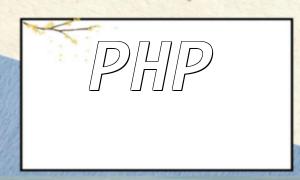Data filtering is an essential task in PHP development to prevent security risks such as malicious attacks, data tampering, and injection. This article introduces several common data filtering methods with practical code examples.
Input filtering involves validating and cleaning user input to prevent malicious data submission. Here are some common input filtering methods:
Frontend validation occurs before user data is submitted, using technologies like JavaScript to check data. This method enhances user experience and reduces server load. For instance, you can use regular expressions to validate the format of an email address:
<form action="submit.php" method="post">
<input type="email" name="email" id="email" required>
<input type="submit" value="Submit">
</form>
<script>
document.getElementById('email').addEventListener('input', function() {
var value = this.value;
var regex = /^[a-zA-Z0-9._-]+@[a-zA-Z0-9.-]+.[a-zA-Z]{2,4}$/;
if (!regex.test(value)) {
this.setCustomValidity('Please enter a valid email address');
} else {
this.setCustomValidity('');
}
});
</script>
Backend validation involves verifying and filtering data on the server side, which is more reliable as users can't bypass server-side checks. Some common backend validation methods include:
PHP provides the filter_var function for filtering and validating data. Here's an example using it to validate an email:
$email = $_POST['email'];
if (filter_var($email, FILTER_VALIDATE_EMAIL)) {
// Email format is valid
} else {
// Invalid email format
}
Regular expressions can be used for advanced validation and filtering of strings. Here's an example using a regular expression to validate a phone number:
$phone = $_POST['phone'];
$pattern = '/^1[3456789]\d{9}$/';
if (preg_match($pattern, $phone)) {
// Phone number is valid
} else {
// Invalid phone number
}
Output filtering involves cleaning and escaping data before displaying it to prevent XSS attacks. Here are common output filtering methods:
The htmlspecialchars function converts special characters to HTML entities to prevent browsers from interpreting them as HTML code. Here's how to use it:
$name = '<script>alert("XSS Attack")</script>';
echo htmlspecialchars($name);
Output:
<script>alert("XSS Attack")</script>
The htmlentities function is similar to htmlspecialchars but escapes more special characters and allows you to specify a character encoding. Here's an example:
$name = '<script>alert("XSS Attack")</script>';
echo htmlentities($name, ENT_QUOTES, 'UTF-8');
Output:
<script>alert("XSS Attack")</script>
This article introduced several common PHP data filtering techniques, including input filtering and output filtering. Input filtering can be done through frontend validation (which enhances user experience) and backend validation (which is more secure). Output filtering prevents XSS attacks, with functions like htmlspecialchars and htmlentities being key tools for escaping special characters. Choose the right data filtering method for your application to enhance security and reliability.









